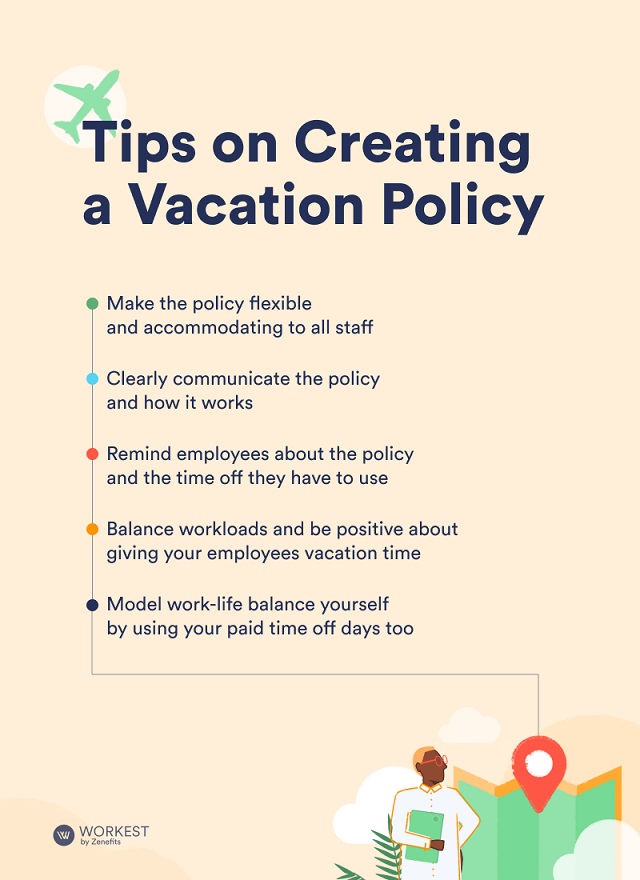
Articles
What Is a Flexible Vacation Policy? Benefits and Pitfalls

With the traditional 9-5 office job fading away, employers need to get creative when it comes to keeping their employees happy, which is why implementing a flexible vacation policy could be just what you're looking for. But what is a flexible vacation policy, exactly?
Flexible paid time off is a new type of leave policy that enables employees to take time off when they need it, without having to accrue or earn the hours. This differs from more traditional PTO policies where employees are allotted a certain number of hours of paid time off for each pay period. A flexible PTO policy can be used for vacations, sick leave, appointments, family emergencies — basically, any reason that would otherwise cause them to be absent from work.
Flexible PTO policies are becoming increasingly popular with progressive companies that prioritize employee satisfaction by measuring performance by output rather than hours worked. Flexible time can deliver huge cost savings as many employees don’t take time off to save their PTO for an emergency. This leads to unused vacation days that employers have to pay out.
A flexible time policy can have numerous benefits that make everyone happier in the long run, but there are also potential pitfalls. We'll explore these topics further throughout this blog post, so stick around if you want all of the details about a flexible vacation policy.
What is a Flexible Vacation Policy?
Flexible paid time off (PTO) is a type of leave policy that combines vacation, sick, and personal days into one bank of hours. This allows employees to use their PTO in whatever way works best for them — whether it’s taking a day off to go on vacation or using an hour here and there for doctor’s appointments.
The idea behind an unlimited vacation policy is that it gives employees the freedom to manage their own time without having to worry about being penalized for taking too much or too little time off. It also shows employers trust their staff enough to be responsible for their work-life balance.
For businesses, offering unlimited vacation can help improve employee morale and productivity by allowing them more control over how they use their time away from work. It also helps create a better culture where employees feel appreciated and valued as individuals instead of just another cog in the machine.
Since many companies offer competitive benefits packages these days, offering unlimited vacation policies could give your business an edge when recruiting new talent.
Flexible PTO vs Unlimited PTO
Flexible and unlimited paid time off policies are often used interchangeably, but there’s an important difference between the two.
Unlimited PTO policies are truly unlimited — employees can take as much or as little time off as they desire.
But what is a flexible vacation policy?
Flexible PTO policies can be flexible in terms of what kind of time employees take off, but employers may still impose caps on the amount of time allowed.
Evidence suggests that having a flexible or unlimited policy doesn't lead to chaos. Instead, employees still request time off and the team works to ensure no balls are dropped. In fact, one CEO ran an unlimited PTO experiment at his company a few years back and found that employees took roughly the same number of vacation days under this policy as when accrued in a more traditional system.
Flexible PTO offers flexibility without sacrificing structure or productivity within your organization. Plus it shows how you value your employee's work-life balance which could be beneficial from both a morale standpoint and in terms of recruitment efforts.

Benefits of a Flexible Time Policy
An unlimited vacation policy offers a range of benefits to both the employer and employees.
For employees, having flexible PTO means they can take time off when it suits them best — whether that’s for personal reasons or simply to recharge their batteries. This freedom and autonomy can make them happier in their job, resulting in improved performance at work.
On the employer side of things, there are plenty of advantages too. With unlimited vacation policies, you don’t have to worry about tracking accrual rates or rolling over unused vacation days from one year to the next — making it much simpler for HR to manage this process.
And if you need someone back at work quickly after taking some time off? Flexible time makes it easy.
A flexible vacation policy can be a great way to boost employee morale and productivity. Studies have shown that when employees are given the freedom to take time off when they need it, they’re more likely to be engaged in their work and motivated to succeed.
A flexible time policy allows employees to take breaks from work whenever needed, allowing them to come back feeling refreshed and energized. This leads to an increased focus on tasks at hand and higher levels of productivity overall. Giving employees control over their own schedules also helps reduce stress at work.
Employees who feel valued by their employers tend to stay longer with the company than those who don’t feel appreciated or supported. By offering unlimited vacation time, you show your staff that you care about their well-being and recognize how important it is for them to take time away from work every now and then.
Of course, there are still considerations around implementing any new policies within your business, but with careful planning and clear communication between management and employees, businesses can reap the rewards of an unlimited vacation time policy.
The Downside of a Flexible Vacation Policy
Flexible time off policies can be a great way to reward employees and keep them engaged, but there are some potential downsides that employers need to consider.
One of the biggest risks is abuse. If you don’t have clear rules in place, it’s easy for people to take advantage of your generosity and end up taking more than their fair share of leave. This can lead to decreased productivity and morale issues among other team members who feel like they’re picking up the slack.
Another issue is that when employees have unlimited vacation days, they often feel guilty about taking any at all. This means managers need to actually encourage their staff to take breaks – something which isn't always easy with busy schedules or tight deadlines looming.
If an employee takes too much time away from work, they may find themselves unable to pick up where they left off when returning back into the office environment. This could lead to delays in project completion as well as difficulty catching up with tasks that have been assigned while out on leave. Therefore, it's important for managers to plan ahead so that projects are not delayed due to extended absences.
Depending on your company's size and structure, you may need additional HR personnel or software systems in order to track requests accurately. This could add extra costs which might not be feasible for small budgets.
Finally, if you have team members who rely heavily on each other for certain tasks, then granting unlimited flexibility might cause problems with workflow continuity due to someone being absent. This can be mitigated through proper communication and advanced notices.
How to Make Flexible Time Off Policies Work
Time off policies can help create a positive and productive workplace, but they need to be implemented correctly in order for them to work effectively.
What is a flexible vacation policy and how can you make it work?
Set clear expectations with your team. Let them know that leave is available when needed, as long as productivity goals are met.
Track absences carefully. Set up a system for tracking FTO so you can identify patterns of abuse or issues with team members not taking enough time off. Also, keep track of planned leave on a team-wide vacation calendar so there’s no confusion when people are away from work.
Respect the policy yourself. Let employees be flexible with their time off, as long as they get the job done. Don’t make people feel guilty for taking days off unless it’s a clear case of abuse or misuse of the policy.
Create a positive attitude around paid time off by making it clear to employees that you care about their overall well-being. This will help foster an environment where people actually take advantage of their FTO benefits without feeling guilty about it.
Finally, remember that these policies exist to help your people find a balance between their work and personal lives. If implemented properly, FTO policies should lead to happier staff who are more productive at work too.
Conclusion
What is a flexible vacation policy? A flexible PTO can help create an environment of trust and respect, while also providing the freedom for employees to take time off when they need it most. If you're looking for ways to make your business more attractive to potential hires or just want to reward your current team members, consider implementing a flexible vacation policy.
Are you an entrepreneur, founder, manager, or operational leader looking for a way to grow and scale your business while providing superior onboarding, offboarding, and training experiences? Trainual can help.
Take advantage of our innovative approach today and start scaling your organization!
Similar Blog Posts







